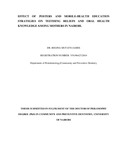| dc.description.abstract | Health education describes any combination of learning opportunities designed to equip the individual and/or community with appropriate knowledge, attitudes and skills to maintain and improve their health. Mobile health or mhealth is defined as ‗medical and public health practice supported by mobile devices, such as mobile phones, patient monitoring devices, personal digital assistants (PDAs), and other wireless devices‘. Kenya has in the recent past recorded exponential growth in mobile telephone and internet use. This development has led some researchers to recognize an opportunity for health education using such electronic platforms. Objective: To evaluate the effect of health education messages using posters and mhealth approaches on teething beliefs and oral health knowledge among mothers attending two health centres in Nairobi.
Research Design: This was quasi-experimental intervention study Study Area: The study was conducted in two level 3 Health Centres in Nairobi Study Population: Mothers presenting babies aged 0-3 months for growth monitoring and immunization programs at two conveniently selected level 3 Health Centres were sequentially recruited into the study.
Study Procedure: Baseline data was collected among consenting mothers following which they were allocated to either the mhealth or the poster education groups according to their health centre. All mothers were followed over a period of six months with health messages and were contacted using their mobile phones for final data collection.
R.M.J PhD Thesis - 2015 Page xvii
Data collection tools: Pre-tested researcher-administered questionnaires were used to collect both pre- and post-intervention data among consenting mothers. Allocation to Intervention Group: The two participating health centres were allocated to either poster group or mhealth education group randomly. Intervention: Posters containing oral health messages were put up in the „poster‟ intervention clinic and changed monthly to ensure adequate coverage of the intended health messages. The mhealth intervention group received short text messages send to their mobile phones every month to ensure equal coverage of content as contained in one poster message within the month. Data Analysis and Management: Data was coded and entered into Statistical Package for Social Sciences (IBM® SPSS® Statistics) computer software Version 20. Descriptive statistics were generated on demographic characteristics, living conditions, personal experiences with child‟s teething and management of teething-related symptoms. Comparison of pre- and post-intervention scores for oral health knowledge and association of teething with childhood illnesses for mothers was done using the McNemars test for significance for the poster and mhealth groups.
Results: A total of 399 mothers were sampled for baseline data. There were 200 mothers from Westlands Health Centre and 199 mothers were from Makadara Health Centre. Mothers‟ age ranged from 19 to 48 years (Mean 28.25, SD 4.587). Majority of mothers had inadequate knowledge regarding the association of fever 288(76.4%) and diarrhea
R.M.J PhD Thesis - 2015 Page xviii
278(73.9%) with teething. About a third (n=122) of mothers regarded vomiting to be associated with teething. After the six-month education period, the post-intervention response rate was recorded at 52%, and 102 mothers from the mhealth and poster groups were successfully contacted on phone. There was improvement in mothers knowlegde on association of teething with childhood illnesses using both the posters and mhealth education approaches. The proportion of mothers associating teething with diarrhea decreased from 53.8% to 47.1% for the mhealth group, and from 78.0% to 36.7% for the poster group. Similarly, there was a decrease in the number of mothers associating vomiting with teething from 36.5% to 18.8% for the mhealth group and 52.5% to 12.9% for the poster group. Association of local symptoms with teething increased for itchiness of gums from 50% to 83.9% for poster group, and from 36.5% to 82.4% for the mhealth group. The mean score for knowledge on risk factors for ECC increased from 3.32(SD 1.6) to 4.17(SD 1.2) for the mhealth group, and from 2.43(SD1.3) to 3.73(SD 1.5) for the poster group. Improvements in mean scores were also recorded for knowledge on prevention of ECC and dental fluorosis for the two groups. Mothers with good oral health knowledge increased for both poster and mhealth groups by an average of 41.4% points from the baseline. The proportion of mothers with good knowledge increased by 38.8% points for the poster group and 29.8% points for those who received mhealth education.
Using ANCOVA to control for mothers differences at baseline, there was no statistically significant difference noted in the performance of posters and mhealth for the post-intervention scores (p=0.584).
R.M.J PhD Thesis - 2015 Page xix
Conclusion: Overall, both poster and mhealth health education strategies were effective in improving knowledge on association of teething with childhood illnesses and oral health literacy. Oral health education should be delivered in programmes targeting maternal child health welfare to improve oral health outcomes | en_US |
| dc.description.department | a
Department of Psychiatry, University of Nairobi, ; bDepartment of Mental Health, School of Medicine,
Moi University, Eldoret, Kenya | |

